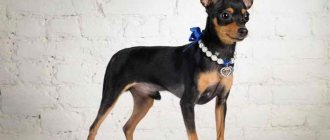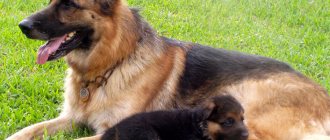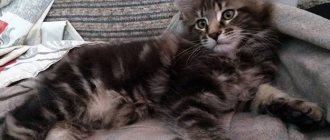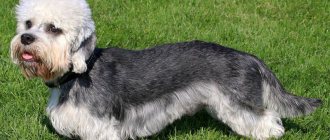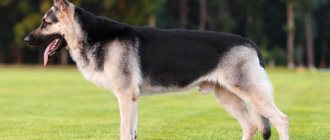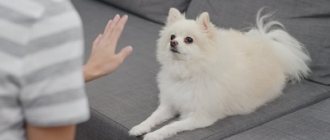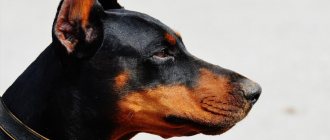Video
* We invite you to watch a video about the Prague Rat . In fact, in front of you is a playlist in which you can select and watch any of 20 videos about a given dog breed by simply clicking on the button in the upper right corner of the window. In addition, the material contains quite a lot of photos. By looking at them you can find out what the Prague Ratman looks like.
In this article:
|
Rate the material!
[Total votes: 3 Average: 5]
The Prague Rat Dog is a small but incredibly positive dog that can cheer up even the most gloomy person. The Ratman is often confused with a Chihuahua, since these breeds are quite similar and it is easy for a person far from cynology to confuse them. In this article we will talk about this graceful dog, tell you about its character and teach you how to choose the right puppy of this breed
Breed nurseries
List of nurseries where you can safely buy a ratlik and not be afraid of being deceived:
- https://ratlikdog.ru/kontakty.html St. Petersburg, mono-breed nursery “GALIVAS”;
- https://www.prazsky-krysarik.ru/ Moscow, nursery “From the constellation Niki”;
- https://www.ratlik.org/ Moscow, nursery “Ratlik-blues”;
- https://krysarik.ucoz.ru/ Moscow, nursery “Grand League”;
- https://www.millgret.breeder.ee/ Estonia, Tallinn, nursery “Millgret”.
The Prague Rat is a breed that, once settled in a house, will remain there forever. The love of this little dog is so selfless and boundless that it wins a person’s heart for life.
The history of the origin of the Prague rats
The homeland of the Prague rat is the Czech Republic, and the history of the breed goes back to the Middle Ages. In the Middle Ages, European cities experienced real invasions of mice and rats, and cats simply could not cope with so many rodents.
By order of King George, a breed of dogs distinguished by their compact size and strong hunting instinct was bred from Poděbrad. This is how the Prague rats appeared. Their size is only slightly larger than that of a cat, but their activity and aggressiveness is much higher.
Interesting fact: Initially, Prague rats belonged only to noble and wealthy citizens. They lived in large houses, and several of these dogs were quite protective of small rodents. Very soon the popularity of these dogs spread throughout Europe, and in the 14th century the kings of Bohemia (the ancient name of the Czech Republic) gave these rat dogs to the rulers of other countries.
Thus, the Prague rats ended up in France, Germany and Belgium. Moreover, in addition to catching rats and mice, these dogs were used as food tasters. At this time in Europe, they very often got rid of crowned persons with the help of poison, and the rats were allowed to walk around the tables unhindered and try any food from the royal diet. It was believed that the dishes that the Prague rat tried were completely safe and did not contain poison.
In the 18th century, a political and economic crisis began in the Czech Republic and the Prague Rat Dogs turned from dogs of aristocrats into another common breed of animals. Commoners began to own rat hunters, and they were no less willing to clear the shacks of the poor of rats and mice.
The first, and then the second, world war almost completely destroyed the Prague rat breed. With incredible work and effort, the species was restored in the 70s of the last century by the Czech breeder Jan Findeis. However, to this day the breed has received only limited international recognition and at this point in time there are only about 3,000 dogs of this species.
Prague Rat - description of the breed
Representatives of this dog breed are distinguished by their miniature size. Prague Rat Dogs are similar at the same time to a Chihuahua, a Russian Toy Terrier, and even a Miniature Pinscher. This is not surprising, since many of the dog breeds mentioned were used in the breeding of the Prague rat rat.
Dog handlers pay great attention to the body proportions of rat dogs. It is important that the height at the withers and the length of the body are combined in proportions of 1:1.05 (maximum 1:1.1). That is, the standard representative of the breed should be built almost perfectly. In addition, the height of the dog at the withers should be twice the volume of the chest, and the width of the head should be equal to its length.
The Prague rat rat has a pear-shaped head, with a pronounced nape. The muzzle is tucked up and without skin folds. The ears are strong, erect, firmly fixed on the head and hardly move. The animal’s neck is elegant, but strong, its head rotates at a fairly large angle.
The small dog's teeth are large (for its size), symmetrical, and has a regular scissor bite. The Prague rat rats have a medium-sized nose and are exclusively black. A nose of a different color is considered a genetic disorder.
The dog's eyes are black or dark plum in color. They are slightly rolled out, and therefore the rat always looks surprised. The body of the Prague rat is almost square, with a lean belly and a flat back. The chest is inexpressive, with a slightly sloping base line.
The paws of dogs of this breed are muscular and spaced quite widely. The hind legs, which are distinguished by powerful joints and strong muscles, deserve special mention. The tail of the Prague rat is located at the same level with the line of the back. It is stopped at an early age at the fourth vertebra. Miniature dogs can be either short-haired or long-haired.
Popular colors of Prague rat rats
In total, there are five colors in the Prague Ratdog breed, which are considered standard.
These include:
- Black (or black and tan);
- Brown (or brown and tan);
- Red (from light yellow to bright sand);
- Chocolate;
- Marble (from light to dark).
If there are tan marks in the dog's color, they should be bright and rich. Blurred tan marks are considered a cull, and such dogs are not allowed for breeding.
Marks can be located on the face, on the throat, on the hind legs, in the tail area and, of course, on the chest. As a rule, the color of tans ranges from dark red to black depending on the base color of the dog.
Interesting fact: Marble is considered the rarest and most sought after color. In recent years, this color has been very popular among breeders. Males and females of this color are primarily allowed for mating.
There are also a few colors that are considered genetic culls. These colors include black-backed and brindle. Such colors appear as a result of incorrectly selected pairs for mating. In most cases, dogs of this color have genetic abnormalities and are not able to produce healthy offspring.
In addition, dogs that have white (or yellow) spots of any size in their color are considered culled. Typically, such spots appear as a result of crossing the rat dog with miniature dogs of other breeds.
In the future, there are no plans to add new colors to the breed standard. In the coming years, it is planned to normalize the colors and divide them into five large groups.
How to choose a puppy
The choice of a future pupil should be based on an understanding of why the puppy is being purchased. The cost and appearance of the dog depends on this. Puppy class options:
- Show class . The highest price is for dogs of this particular class ( about 100 thousand rubles and above). The puppies have the ideal breed exterior to become show champions.
- Breeding class . The price for a puppy is slightly lower than for exhibitions ( 50 – 70 thousand rubles ). The pet has all the characteristics of the breed, but is perhaps a little larger than miniature show dogs. Ideal for breeding.
- Pet class . A dog of this group has the lowest price ( 25 - 30 thousand rubles ), but at the same time there is a full package of documents confirming that it belongs to the breed. The main reason why a pet-class ratlik is not suitable for exhibitions or breeding is, as a rule, a slight deviation from the standard. But this will not prevent such a puppy from becoming a pet or a winner of sports competitions.
It is not advisable to buy a Prague rat rat from your own hands, without a pedigree - the resemblance to that terrier and chihuahua can play a cruel joke. Unscrupulous breeders can deceive an inexperienced dog breeder and sell a more common (and therefore cheaper) dog at triple the price as a rare breed.
Character and habits of Prague rat rats
Rat dogs are excellent ladies' dogs, capable of becoming wonderful companions for both an elderly lady and a young girl. These are incredibly positive dogs, always in a good mood.
In addition to their playful and mischievous nature, Prague rats are very intelligent creatures. They will never pester their owner excessively, will not bark for any reason, and will not endlessly ask to be held.
But with strangers and unfamiliar people, a dog of this breed behaves very warily. The dog will not even allow himself to be petted unless the owner forces him to. In addition, the dog does not like noisy parties and it is definitely not worth taking him to a nightclub or an establishment with loud music.
This dog breed has an excellent relationship with cats. Even if you take a small kitten into your home, the Prague rat will not offend it, but on the contrary, will take patronage over the new pet. But relationships with dogs of other breeds will not work out. Rat cats are too jealous and will not tolerate another dog near their owner.
Also, the dog absolutely cannot stand mice, hamsters and even rabbits. Ratfish consider all small rodents to be their legitimate prey, and will hunt them with all possible enthusiasm.
Interesting fact: Despite their modest size, Prague rat rats are distinguished by amazing fearlessness. Trying to protect the owner, they are able to attack a dog 2-3 times their size.
Dogs of this breed have an overly developed sense of ownership. They will protect their place and their belongings (usually a bowl and toys), and ruthlessly drive out strangers from their territory. Only the owner is allowed to take the dog’s things, but at this time she will closely watch all his movements.
Character
The companion from the Czech Ratlik is wonderful. What does it mean? The dog constantly accompanies the owner, for example, following him around the house with his “tail”. This is touching and suggests the idea of his possible inferiority. No, the tiny dog is self-sufficient and purposeful. Simply love for a person pushes her to the opportunity to seek refuge near him.
The Prague Rat Dog in the photo looks energetic, cheerful and cheerful. There is little that can make him nervous, angry or sad. However, ignoring the owner or household members can.
Remember ! This is a very smart dog. Don't underestimate her intellectual potential. The rat's memorization skill is excellent. Typically, nature does not endow miniature dogs with a good mind.
The character of this animal can be called balanced. He won't fuss or bark for no reason. In an uncertain situation, he clings to his owner, wants to be near him in order to feel protected. Rarely makes decisions on his own and relies on family members.
Has security features. It does not attack guests, but can bite if it senses malicious intent. The owner is notified of their arrival by barking loudly. They are wary of strangers. Doesn't allow anyone to pet him except the owner's friends.
By the way, the most important person in the life of a Prague rat is most often a kind and caring middle-aged woman. A miniature dog is more loyal to representatives of the weaker sex. She often feels like their protector, so she never leaves if there are strangers at home.
Cat lovers can safely adopt a Czech Ratlik, because he has a positive attitude towards them. It's strange, isn't it? Yes, this dog loves cats. Why, you ask? It's all about their common mission to exterminate rodents. Hatred for tailed pests unites the dog and the cat, forcing them to be friends and cooperate.
By the way, it is very rare to find a rat rat who would not get along with a cat in a home environment. But for rat lovers, such a pet is definitely not suitable! Natural intolerance towards them will never disappear in such a dog.
The Prague rat rat is filled with love. He is ready to share it with everyone, especially with babies. The dog is kind to each of the members of his pack, but becomes upset if they do not devote time to her. It is advisable to show your affection to the animal regularly, then it will be properly socialized and become happy.
Interesting facts about Prague rat rats
There are many interesting facts that allow you to learn a lot of new and interesting things about dogs.
The most unusual facts include:
- The breed has been completely restored and has received recognition in many cynological communities, but there is no official world recognition to this day. For this reason, breed standards are not canonical and may change over time;
- Prague rats have a 500-year history, but over such a long period of time they have not lost their hunting instincts. It is enough for a dog to see a white mouse, a hamster or even a jerboa, and it will immediately begin an uncompromising hunt;
- Rats do an excellent job as guards. And although these dogs will not be able to stop a person, they will immediately notify the owner of the stranger with a loud and ringing bark;
- The Czech name for the breed is “ratliki”. It comes from the word “rat”, which means rat. Thus, ratliks are rat eaters. The Czech name for the dog perfectly describes what this breed was bred for;
- To this day, rats are able to assess the quality of food. The dog will never eat bad food or food containing harmful substances. For example, a dog will never eat dairy products with palm oil or artificial sausage;
- Prague rat rats love to make a stash. If the dog cannot eat the food, then it will take it away and hide it in a treasured place. But besides food, the rat is capable of hiding shiny things and objects that he finds attractive;
- Dogs do not tolerate loneliness very well. Even one day spent without their owner will be a severe test for them.
Pros and cons of Prague rat rats
Before getting a puppy of this breed, you need to know all the strengths and weaknesses of the Prague Rat.
Clear advantages include:
- Intelligence and intelligence. Ratliks are distinguished by a very tenacious mind. They cannot be classified as the smartest dog breeds, but the intelligence of these animals is quite enough to become a good friend and companion;
- Devotion. Prague rat rats are very loyal to their owners and cannot live without them even for a couple of days;
- Courage. In an attempt to protect the owner, rat dogs can attack another dog, several times larger than themselves;
- Reliable watchman. Ratliks may well serve as a living alarm system. Dogs have sensitive hearing and are able to hear a stranger several tens of meters away;
- Ideal for keeping in an apartment. Compact size, ease of care and a small amount of food - all this makes this dog incredibly attractive for keeping in a small apartment.
The disadvantages of the Prague Rat are considered to be:
- Tendency to make nest eggs. Very often, the rat makes edible stashes, hiding tasty morsels in the most unexpected places. Often the food rots and then the owner urgently needs to look for the dog’s hiding places;
- High likelihood of obesity. Like many other small dogs, rat dogs love to eat a lot. And it’s not always easy to control the amount of food you eat. If you do not carefully monitor your pet, then in the shortest possible time he will turn into a ball on legs;
- Weak immunity. The Prague rat is susceptible to colds. In autumn and winter, it is very easy for a dog to catch a cold, even during a short walk.
Feeding
Like most dog breeders, rat owners have a choice whether to feed their dog natural food or give preference to ready-made diets. In the first case, the pet will definitely need additional sources of vitamins and minerals.
The animal's diet should consist of:
- meat - lean beef, chicken, rabbit and turkey;
- fish - it is better to give sea fish, previously boiled and cleaned of bones;
- vegetables - they are given both raw and boiled, they can be chopped and seasoned with a small amount of vegetable oil;
- pasta from durum wheat;
- cereals – you can cook buckwheat, rice and oatmeal.
Natural feeding is ideal, but it is extremely difficult to independently calculate the required amount of vitamins and minerals a pet needs daily. In this case, you will need the help of a veterinarian.
When feeding dry granules, it is worth choosing a diet from premium and super-premium products, as they are made from high-quality ingredients in compliance with the proportions. In addition, in this case it is easier to determine the required portion of food and it is possible to select a menu based on the individual characteristics of the pet.
With natural feeding, it is more difficult not to overfeed your pet, since due to their excellent appetite, rat rats are able to eat much more food than required. Given the size of the dog and its physical activity, it is fed two or three times a day, always following the established regime.
Breeding Prague rat rats
Puberty in rats reaches one and a half years. From now on, you can start looking for a suitable match. However, the reproduction of the Prague rat rat is associated with a number of difficulties.
Firstly, there are only 3,000 individuals of this breed in nature, and therefore it is not so easy to find a decent pair for mating. Therefore, very often dogs living in different countries are brought together, which can be very expensive for their owners.
Secondly, it is highly recommended to cross two dogs of the same color, and finding a matching pair of the same color can be very, very difficult. This explains the small number of dogs and the high percentage of culling among puppies.
If a suitable pair is still found, then you need to plan the mating on the 10-11th day of the bitch’s heat. It is very desirable that by this time the dogs are familiar with each other. This will avoid possible problems and simplify the mating procedure. If the dogs are unfamiliar, then you need to let them walk together for at least an hour and only then start mating.
Their small size is not an obstacle to normal mating, and rat rats are able to do without human help. But the breeder must be present during the mating, as this ensures the mating process without injury to the dogs. Every other day it is recommended to re-mate. This increases the chance of pregnancy.
Pregnancy lasts about 6-7 weeks and usually occurs without complications. Childbirth in rat cats is difficult, and it is advisable that the puppies be delivered by an experienced veterinarian. In case of problems and complications, a caesarean section is recommended.
Caring for Prague rat rats
It should be remembered that the Ratlik is a decorative dog, and it requires appropriate care. First of all, you need to ensure that the dog has its own sleeping place. It could be a special basket or house purchased for the dog. If you do not equip a sleeping place, then there is no doubt that the animal will come to sleep in the owner’s bed or will consider a sofa or chair as its place.
In addition, the dog should have several (at least 3-4) toys. These could be squeaky toys, balls, or just chewing bones. By not purchasing toys, the dog owner runs the risk that the Prague rat will play with slippers, wires from household appliances and baseboards.
Ratlik is a very heat-loving animal. The optimal temperature for walking is + 15-25 degrees above zero. If the air temperature drops below +10 degrees, then the dog must be walked in special clothing. When there is significant frost, it is better not to walk the dog at all, as it catches a cold very easily.
Interesting fact: Ratliks are very easy to train to relieve themselves in a tray or a special diaper. You can use closed litter trays for cats. Prague rat rats easily get accustomed to such a toilet, and this comes in very handy, especially in the winter season. But this does not mean that the dog does not need to be walked at all.
Both short-haired and long-haired varieties of Ratlik need to be combed once every 2-3 days. Since this is a miniature dog, it would be the right decision to purchase a special mitten brush. This will allow you to comb the animal quickly and efficiently.
The dog has erect ears. Dust and small debris easily get into them. You should check (and clean if necessary) your ears once a week. To do this, you should use cotton swabs. The dog has bulging eyes. They need to be washed with an herbal solution once every two weeks. If pus appears in the corners of the eyes, the rat needs to be shown to a veterinarian.
Education and training
A Prague Rat puppy, like most other dogs, should be raised and socialized from the moment it appears in the apartment. Czech warriors are also dominant, and if you don’t set the boundaries of what is permitted in time, they will quickly sit on your neck. At the same time, it is very important that until the age of 7 weeks the baby is with his mother and his brothers. In the future, time spent with the family will help the dog build relationships with the person and find its place in the canine team.
Otherwise, ratliks are typical lap dogs, greedy for praise, tasty incentives and outright flattery, so if you want to teach a ratlik something, do not skimp on affection and compliments. Never, under any circumstances, physically punish an animal. Firstly, you risk injuring an overly fragile pet, and secondly, you will forever discourage him from working in pairs with you. However, it is unlikely that you will raise your hand to such a groovy charmer, so the main problem facing the owners of the breed is not even upbringing and training, but the ability to restrain one’s own emotions at the sight of these touching creatures. Don’t forget that Prague rat rats subtly sense the mood of their owner, and if you give in, they will not miss an opportunity to turn the matter in their favor. Have a positive attitude towards the activities, but try not to spoil your pet, so that later you don’t grab your head from the dirty tricks and destruction he has caused.
As for training programs suitable for the Prague rat, the best option for him would be OKD. Yes, yes, these little ones do an excellent job with the General training course. Moreover, a ratlik that has been trained and has understood the basics of etiquette will cause fewer troubles on walks: remember about the breed’s passion for chasing and reluctance to give in in disputes with larger relatives. Rats are also capable of distinguishing themselves in sports disciplines. They are best given obedience standards such as obedience, as well as all kinds of “catch-up” (coursing).
Diet of Prague rat rats
The rat is a decorative dog, and it needs to be fed at the highest level.
There are three types of food for the Prague rat rat:
- Artificial food. The easiest way to feed a rat. Dry food from leading manufacturers is fully balanced. They contain proteins, fats and carbohydrates in the required proportions, and also add vitamins necessary for the health of the dog. It is enough to feed an adult dog 2 times a day (morning and evening) and it will live a long and active life. The only peculiarity of such feeding is that the Prague rat rat should always have access to clean water. Dry food causes extreme thirst, and the dog will inevitably want to drink;
- Natural food. This feeding method is suitable for people who have a lot of free time. You will have to prepare the dog's food every day, and this takes a lot of time. The main diet of a rat's natural diet is lean meat. You can give your dogs beef, lean pork, chicken, rabbit and turkey. The only exception is lamb, which is harmful to ratlik in all forms. In addition, you can add boiled fish (pollock or pink salmon) to your dog’s diet, as well as fresh vegetables such as carrots or cabbage leaves;
- Mixed feed. Most owners adhere to this type of feeding. If you feed your ratlik with mixed food, then 80% should come from artificial nutrition and 20% from natural food. It usually looks like this: several times a week the dog receives small portions of fish and meat, and all other days it is fed dry food.
An adult dog needs to be fed 2 times a day, but a puppy should be fed 5-6 times a day. Your baby's diet should always include cottage cheese, eggs and high-quality meat products. Only with such a diet will a dog develop a strong skeleton and healthy joints.
Breed characteristics
| Short description | |
| Origin: | Czech Republic |
| Conditions of detention: | Private house or apartment |
| Purpose: | Hunter, companion |
| Color: | With tan – black, brown, blue (the rarest); deer, marble |
| Wool length: | For short-haired dogs 0.5 – 1 cm, for long-haired dogs from 1 cm on the body to 6 cm on the feathers |
| Adult dog size: | Height from 18 to 22 cm, average weight 2.5 kg (no more than 2.6 kg) |
| Average life expectancy: | 12 – 14 years old |
| Walk: | Daily walks of up to 1 hour per day are required |
| Physical activity needs: | High level of needs |
| Fédération Cynologique Internationale (FIC) classification: | Not recognized by the IFF |
| Puppy price: | From 15 thousand rubles. for a puppy without documents, from 100 thousand rubles. for a show class dog |
Diseases and health problems
Unfortunately, the Prague rat cannot boast of good health and ideal immunity. This is a very fragile creature and dog owners need to constantly monitor their health.
First of all, you need to protect your dog from jumping and falling from great heights. Often, after playing too much, a dog is capable of making a rash jump, which will end in the saddest way.
Prague rat rats often break their front or hind legs, and this is quite a serious injury, considering that it is very difficult to find a veterinarian-traumatologist.
Important fact: The weak point of ratliks is their increased heat tolerance. When the temperatures outside are below freezing, it is recommended to walk the dog for no more than 10-20 minutes. It is advisable to dress the dog in a special overall. Otherwise, there is a high probability of the animal catching a severe cold.
Another “signature” disease of the Prague rat rats is considered to be obesity or volvulus. Small dogs do not eat in moderation and it can be very difficult for the owner to limit their diet. As a result of overeating, a dog may experience intestinal volvulus, which can only be treated with surgery. As practice shows, more than 30% of all rat rats are obese, which affects their health in the most negative way.
Another 10% of all rat rats suffer from hypoglycemia (low blood sugar). This disease occurs as a result of poor diet, which causes dogs to have low blood sugar. To get rid of this disease, it is necessary to completely change the dog’s diet, give it special medications, and sometimes pieces of refined sugar.
